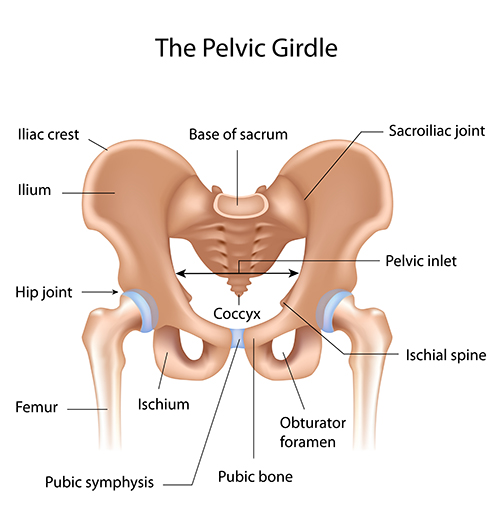What Is SI Joint Fusion?
Where is the sacroiliac (SI) joint located? Is it part of the spine or part of the hips? It’s a little bit of both.

The sacrum, along with the coccyx, is the lowermost part of the spine. The sacrum is a wedge-shaped piece of bone that sits below the lowest lumbar vertebra. It consists of five fused vertebrae labeled S1 through S5.
The SI joints (there are two—one on each side of the sacrum) are where the ilium bones meet the spine. Together they create the pelvis. Pain or abnormal movement at the SI joint can often be solved by fusing the sacrum and the ilium.
What Does SI Joint Fusion Treat?
The SI joint can be an unexpected source of pain. It’s often mistaken for or masked by pain in the lumbar spine, or lower back. SI joint fusion is one possible treatment for pain caused by the SI joint.
Some research suggests that SI joint pain can be responsible for up to 50 percent of pain cases after the patient has already had a lumbar fusion. The SI joint is held together with numerous ligaments, which makes it relatively immobile compared to many other joints. If the ligaments loosen, or if previous lumbar fusion surgery disrupts the SI joint, abnormal movement of the joint can lead to pain.
Who Is a Candidate for SI Joint Fusion?
To be considered for SI joint fusion, an orthopedic spine specialist must first establish that the SI joint is causing pain, and not something in the lumbar spine, buttocks or thighs. Assuming SI joint function is identified, the next step is usually conservative treatment.
Conservative, nonoperative treatment can include:
- Physical therapy and stretching
- Corticosteroid injections
- Nerve blocks
- Oral anti-inflammatories
If nonoperative treatments have not worked to relieve SI joint pain, fusion surgery may be necessary.
How Is SI Joint Fusion Performed?
SI joint fusion is similar to other types of spinal fusion but has extra hardware. A lumbar or cervical spinal fusion creates an environment that encourages vertebrae to grow together by adding a piece of tissue (a bone graft) to act as scaffolding.
SI joint fusion also uses a bone graft to encourage the sacrum and ilium to grow together, but it adds titanium implants. These implants—three are usually used—are similar to those used to reduce and immobilize a fracture with screws. Their purpose is similar: to immobilize the joint and hold it together as the body creates new tissue to fuse the sacrum and ilium.
SI joint fusion is typically a minimally invasive procedure in which multiple small (2 to 3 centimeter) incisions are made with small tools, and a flexible camera is used to visualize inside the area. It is also an outpatient procedure, meaning no hospital stay is necessary.
How Is Recovery from SI Joint Fusion?
Because it takes time to build new bone, a full recovery from an SI joint fusion may take up to six months. Most patients are able to walk immediately, but it is advisable to use crutches or a cane for a period of weeks to months to reduce the stress on the joint.
Physical therapy is often necessary after the procedure. Physical therapy is aimed at strengthening the hip muscles and returning range of motion to the hips.
Patient satisfaction for this procedure is generally very high; one study reported 100 percent satisfaction. Most patients also report a significant reduction in pain.
If you have lower back pain, especially after lumbar fusion surgery, an SI joint fusion may help. Request an appointment at Edison Spine Center to speak with our orthopedic spine experts.
